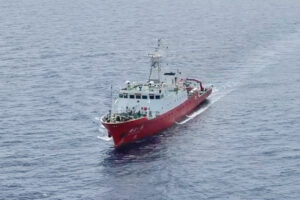
Beijing deployed research vessel near Palawan, not leaving soon — analyst
By Kyle Aristophere T. Atienza and John Victor D. Ordoñez, Reporters
CHINA has deployed a research vessel to features west of the Philippine island of Palawan to signal it is not leaving its neighbor’s exclusive economic zone in the South China Sea despite agreeing to ease tensions in the waterway through dialogue, a security analyst said at the weekend.
Chinese research vessel Ke Xue San Hao was last seen at about 4 a.m. on Sunday 30 kilometers east of Sabina Shoal, said Raymond M. Powell, a fellow at Stanford University’s Gordian Knot Center for National Security Innovation. It was moving north, he added.
Sabina Shoal is part of the Spratly Islands and falls within the Philippines’ exclusive economic zone. It is 123.6 nautical miles from Palawan Island, which is facing the South China Sea.
“In sending the survey ship to within 40 nautical miles of the coast Palawan, China may be signaling its intent to keep the pressure elsewhere in the West Philippine Sea despite loosening its blockade of the Philippine outpost,” Mr. Powell said, referring to Manila’s outpost at Second Thomas Shoal.
Manila and Beijing on July 2 reached a “provisional arrangement” for Philippine resupply missions to the shoal, which the Philippines calls Ayungin.
They resumed talks to ease tensions in the waterway after accusing each other of raising tensions in disputed shoals and reefs in the South China Sea.
Mr. Powell noted that the Chinese research vessel had left Sanya port at Hainan Island on July 19, two days before the Philippine Department of Foreign Affairs (DFA) announced it had concluded a deal with China to resume resupply missions to BRP Sierra Madre.
Manila grounded the World War II-era ship at the shoal in 1999 to bolster its sea claim.
The research vessel has sailed through submerged features near Sabina Shoal such as First Thomas Shoal, Half Moon Shoal, Bombay Shoal, Royal Captain Shoal, Northeast Investigator Shoal and Boxall Reef after passing by China’s military base at Mischief Reef on July 26, Mr. Powell said, citing satellite imagery.
He said the ship passed within 600 meters of First Thomas Shoal, which is about 35 kilometers south of Second Thomas Shoal.
This is the first recorded appearance of the Ke Xue San Hao in Philippine waters since May 2020, when it explored an area 60 nautical miles east of northern Luzon over four days, he pointed out.
The Philippine Coast Guard (PCG) said in a 4 p.m. update on Saturday that it had been monitoring the ship through a dark vessel technology donated by Canada.
“The vessel has exhibited irregular automatic identification system (AIS) transmissions while navigating in the northern part of Escoda Shoal,” PCG spokesman Jay Tristan Tarriela said in an X post.
He added that the PCG vessel BRP Teresa Magbanua has been “physically tracking” the Chinese research vessel since it passed her dead astern from about 5.5 nautical miles.
Ke Xue San Hao left Mischief Reef on July 26 and has since passed through several critical locations including Second Thomas Shoal, Raja Soliman Shoal, Bulig Shoal, Hasa Hasa Shoal, Abad Santos Shoal and eventually reached Sabina Shoal.
The research vessel, which was designed by the Marine Design and Research Institute of China and built by Wuchang Shipbuilding Industry Co., is “equipped with advanced technology that enables comprehensive marine environment observation, detection, sampling, and analysis,” Mr. Tarriela said.
“The Philippines does not engage in bloc politics, but pursues cooperation for its national interest, which is based on international law,” Don McLain Gill, who teaches international relations at De La Salle University, said in a Facebook Messenger chat. “The problem lies in Chinese expansionism, to which Manila must act upon as a sovereign state.”
Last week, the Chinese Foreign Ministry said a Philippine-US tag team against China would worsen tensions in the South China Sea, after Washington committed to give Manila $500 million (P29.3 billion) in military aid.
“The Philippines needs to see that ganging up with countries outside the region to engage in confrontation in the South China Sea will only destabilize the region and create more tensions,” Foreign Ministry spokesman Lin Jian told a news briefing in Beijing on Wednesday.
He said Manila should focus on engaging in dialogue and consultation instead of allowing the United States to “interfere in the maritime issue.”
US Secretary of State Antony Blinken and US Defense Secretary Lloyd Austin III announced the new military funding in Manila last week after their 2+2 ministerial dialogue with Philippine Foreign Affairs Secretary Enrique A. Manalo and Defense Secretary Gilberto C. Teodoro, Jr.
“To seek security assurance from external forces will only lead to greater insecurity and turn oneself into someone else’s chess piece,” the Chinese spokesman said.
But Foreign Affairs spokesperson Ma. Teresita C. Daza said the Philippines does not intend to destabilize the region with its military cooperation with the US.
“It is the Philippines’ sovereign right to engage with whichever country we choose,” she told BusinessWorld in a WhatsApp message, commenting on the Chinese Foreign Ministry’s remarks.
“The South China Sea is important to the Philippines as well as the region and we want the South China Sea to be a sea of peace, stability and prosperity.”
China claims more than 80% of the South China Sea, overlapping with the exclusive economic zones of Vietnam, Malaysia, Brunei, Indonesia and the Philippines.
A United Nations-backed tribunal in 2016 voided China’s claim over the waterway for being illegal. Beijing has ignored the ruling.
“The Philippine government is wise to ignore these protests (from China) and continue to strengthen its position by building its network of like-minded allies and partners,” Mr. Powell said.



